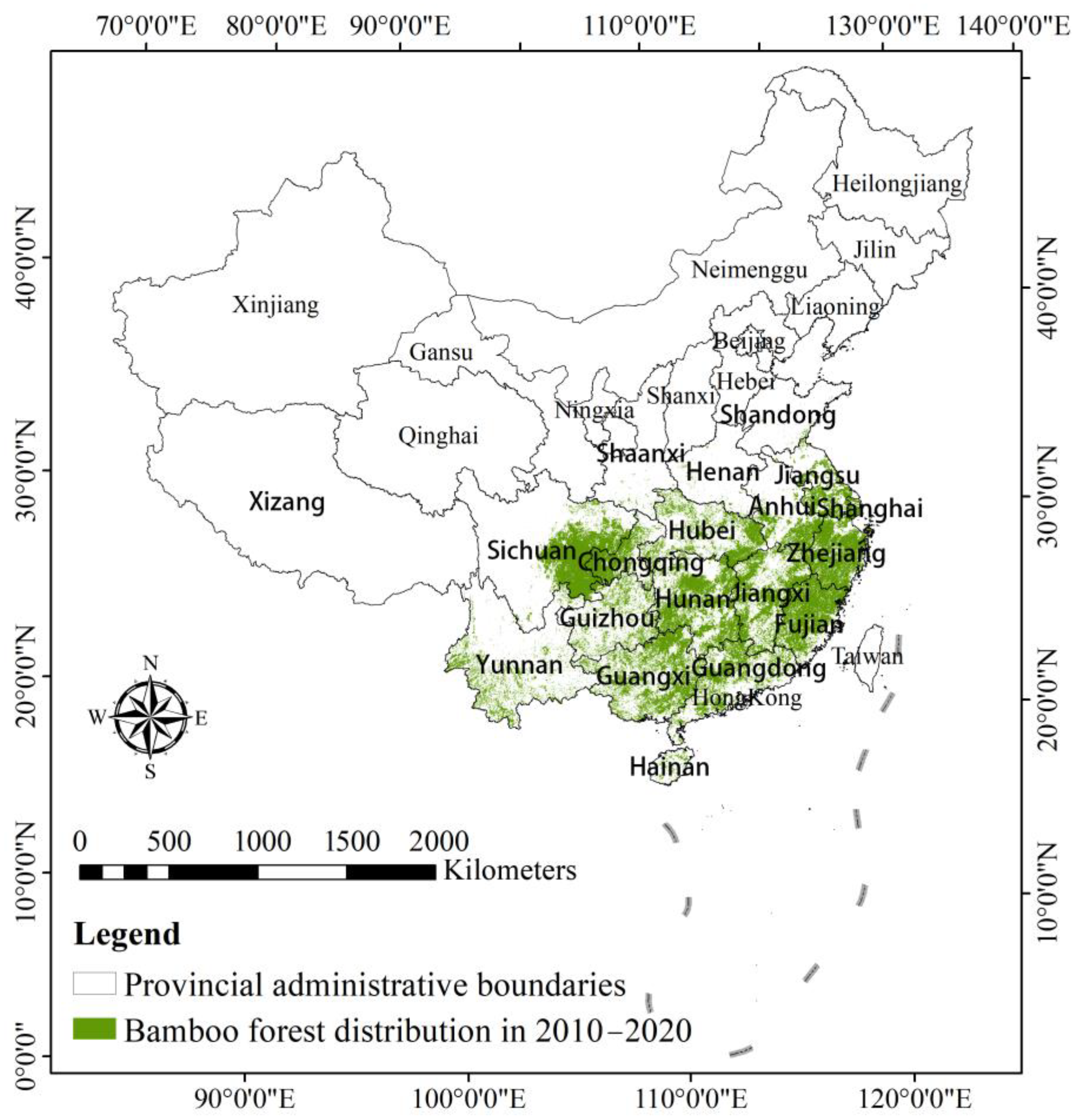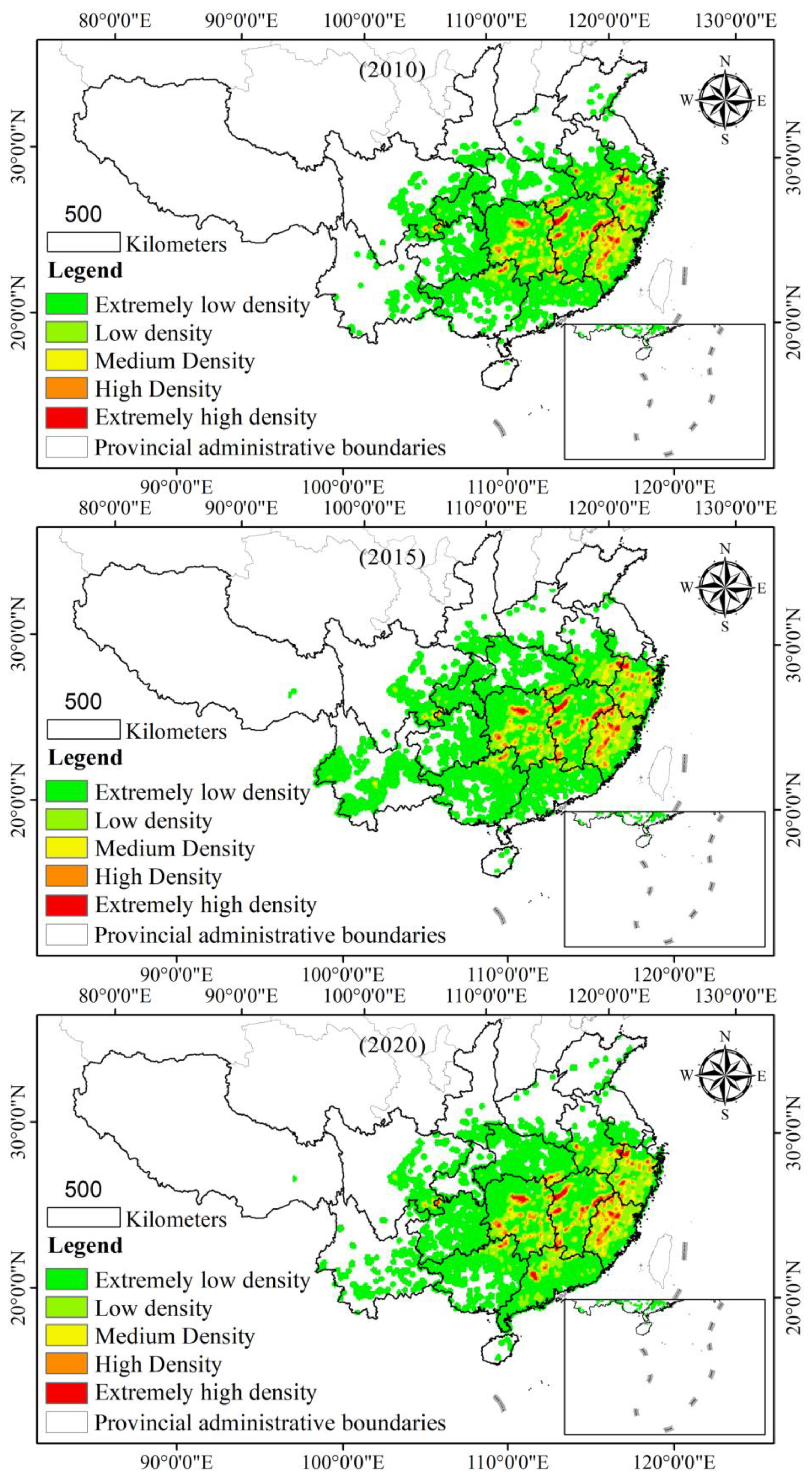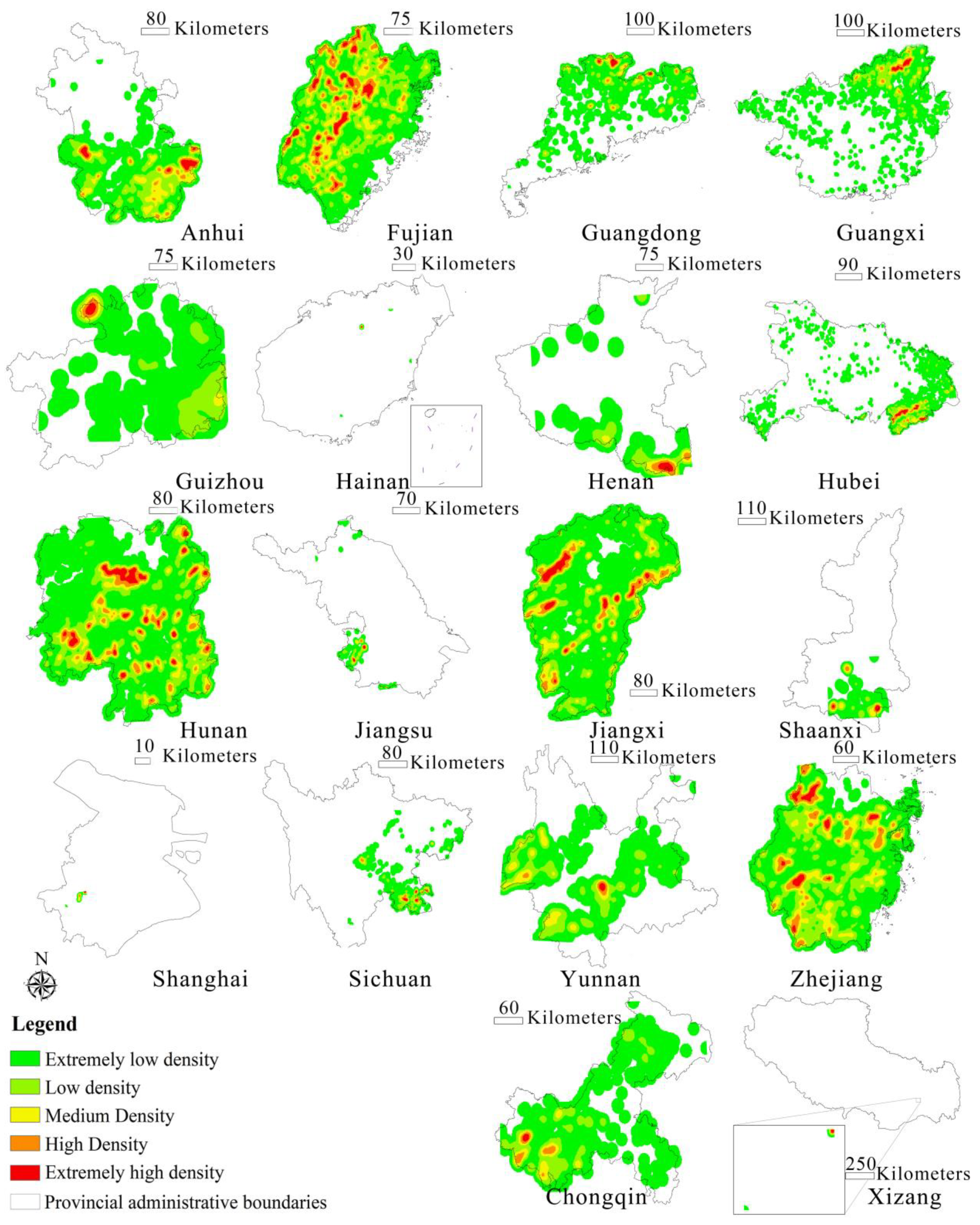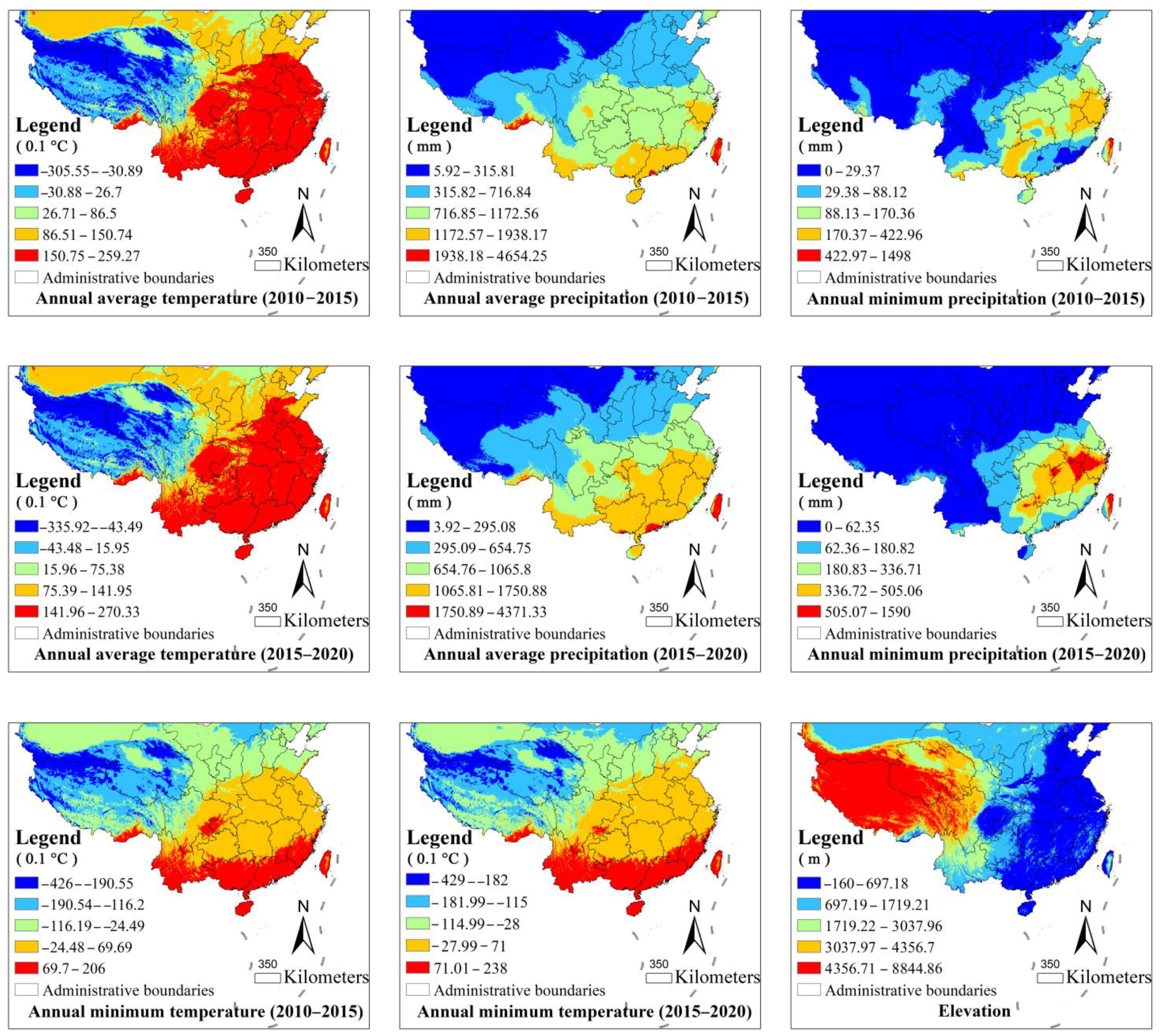Explaining Landscape Levels and Drivers of Chinese Moso Bamboo Forests Based on the Plus Model
Abstract
1. Introduction
2. Materials and Methods
2.1. Data and Processing
2.1.1. Chinese Moso Bamboo Forest Database
2.1.2. Driving Factor Selection
2.2. Methods
2.2.1. Kernel Density Analysis
2.2.2. Landscape Fragmentation Analysis
2.2.3. Patch-Generating Land Use Simulation Model
3. Results
3.1. Spatial Clustering Analysis of Moso Bamboo Forest
3.2. Spatial and Temporal Dynamics of Moso Bamboo Forest Landscape Patterns
3.3. Drivers of Landscape Change in Moso Bamboo Forests
4. Discussion
5. Conclusions
- (1)
- The spatial distribution of Chinese moso bamboo forests demonstrates considerable variation. The range of moso bamboo forests is expanding in both the north and the southwest.
- (2)
- China’s moso bamboo forests expand rapidly between 2010 and 2020. The landscape of the bamboo forest becomes more fragmented, the aggregation reduces, and the overall landscape quality declines.
- (3)
- Changes in the landscape pattern of moso bamboo forests are attributable to the interaction of natural and socioeconomic causes. In terms of change, the climate is the most influential factor in the dispersion of the moso bamboo forest landscape; location considerations are secondary impacts. The landscape change in moso bamboo forests is influenced by the intersection of socioeconomic factors such as location, population density, and GDP with biological geographic features.
Author Contributions
Funding
Data Availability Statement
Acknowledgments
Conflicts of Interest
References
- Scurlock, J.M.O.; Dayton, D.; Hames, B. Bamboo: An overlooked biomass resource? Biomass Bioenergy 2000, 19, 229–244. [Google Scholar] [CrossRef]
- Chen, X.; Zhang, X.; Zhang, Y.; Trevor, B.; He, X. Changes of carbon stocks in bamboo stands in China during 100 years. For. Ecol. Manag. 2009, 258, 1489–1496. [Google Scholar] [CrossRef]
- Yuen, J.Q.; Fung, T.; Ziegler, A.D. Carbon stocks in bamboo ecosystems worldwide: Estimates and uncertainties. For. Ecol. Manag. 2017, 393, 113–138. [Google Scholar] [CrossRef]
- Zhou, G.; Meng, C.; Jiang, P.; Xu, Q. Review of Carbon Fixation in Bamboo Forests in China. Bot. Rev. 2011, 77, 262. [Google Scholar] [CrossRef]
- Ohrnberger, D. The Bamboos of the World: Annotated Nomenclature and Literature of the Species and the Higher and Lower Taxa; Elsevier: Amsterdam, The Netherlands, 1999. [Google Scholar]
- Chen, X.; Zhang, Y.; Zhang, X.; Guo, Y. Changes of carbon storage in bamboo forest in China in the past 50 years. Acta Ecol. Sin. 2008, 28, 5218–5227. [Google Scholar] [CrossRef]
- Song, X.; Zhou, G.; Jiang, H.; Yu, S.; Fu, J.; Li, W.; Wang, W.; Ma, Z.; Peng, C. Carbon sequestration by Chinese bamboo forests and their ecological benefits: Assessment of potential, problems, and future challenges. Environ. Rev. 2011, 19, 418–428. [Google Scholar] [CrossRef]
- Shen, L.; Yang, J.; Zhang, R.; Shao, C.; Song, X. The Benefits and Barriers for Promoting Bamboo as a Green Building Material in China—An Integrative Analysis. Sustainability 2019, 11, 2493. [Google Scholar] [CrossRef]
- Forestry and Grassland Bureau Website. Opinions of Ten Departments on Accelerating the Innovation and Development of the Bamboo Industry. 11 November 2021. Available online: http://www.gov.cn/zhengce/zhengceku/2021-12/07/content_5658570.html (accessed on 12 December 2022).
- Li, X.; Mao, F.; Du, H.; Zhang, M. Spatiotemporal evolution and impacts of climate change on bamboo distribution in China. J. Environ. Manag. 2019, 248, 109265. [Google Scholar] [CrossRef]
- Wang, B.; Wei, W.; Liu, C.; You, W.; Niu, X.; Man, R. Biomass and carbon stock in moso bamboo forests in subtropical China: Characteristics and implications. J. Trop. For. Sci. 2013, 25, 137–148. [Google Scholar] [CrossRef]
- Ali, A.; Ma, W.; Yang, X.; Sun, B.; Xu, M. Biomass and Carbon Stocks in Schima Superba Dominated Subtropical Forests of Eastern China. J. For. Sci. 2014, 60, 198–207. [Google Scholar] [CrossRef]
- Li, Y.; Feng, P. Analysis of bamboo resources in China based on the 9th national forest resources inventory. World Bamboo Rattan. 2019, 17, 45–48. [Google Scholar]
- Vizzari, M.; Sigura, M. Landscape sequences along the urban–rural–natural gradient: A novel geospatial approach for identification and analysis—ScienceDirect. Landsc. Urban Plan. 2015, 140, 42–55. [Google Scholar] [CrossRef]
- Myers, R.; Foale, M.A. Row spacing and population density in grain sorghum—A simple analysis. Field. Crops Res. 1981, 4, 147–154. [Google Scholar] [CrossRef]
- Franklin, J.; Michaelsen, A.H. Strahler Spatial analysis of density dependent pattern in coniferous forest stands. Vegetatio 1985, 64, 29–36. [Google Scholar] [CrossRef]
- Miklós, L.; Špinerová, A.; Belčáková, I.; Diviaková, A. Instruments and tools for sustainable land use and spatial development processes. In Landscape Considerations in Spatial Planning, 1st ed.; Peter Lang: Berlin, Germany, 2019; pp. 33–87. [Google Scholar]
- Bailey, T.C.; Gatrell, A.C. Interactive Spatial Data Analysis; John Wiley & Sons Inc. Harlow. Longman: New York, NY, USA, 1995. [Google Scholar]
- Cai, X.; Wu, Z.; Cheng, J. Using kernel density estimation to assess the spatial pattern of road density and its impact on landscape fragmentation. Int. J. Geogr. Inf. Sci. 2013, 27, 222–230. [Google Scholar] [CrossRef]
- Modica, G.; Vizzari, M.; Pollino, M.; Fichera, C.R.; Zoccali, P.; Fazio, S.D. Spatio-temporal analysis of the urban–rural gradient structure: An application in a Mediterranean mountainous landscape (Serra San Bruno, Italy). Earth. Syst. Dynam. 2012, 3, 263–279. [Google Scholar] [CrossRef]
- Kuter, N.; Kuter, S. Investigation of wildfires at forested landscapes: A novel contribution to nonparametric density mapping at regional scale. Appl. Ecol. Env. Res. 2018, 16, 4701–4716. [Google Scholar] [CrossRef]
- Vizzari, M. Spatial modelling of potential landscape quality. Appl. Geogr. 2011, 31, 108–118. [Google Scholar] [CrossRef]
- Lin, Y.; Hu., X.; Zheng, X.; Hou, X.; Zhang, Z.; Zhou, X.; Qiu, R.; Lin, J. Spatial variations in the relationships between road network and landscape ecological risks in the highest forest coverage region of China. Ecol. Indic. 2019, 96, 392–403. [Google Scholar] [CrossRef]
- Guo, Y.L.; Li, X.; Zhao, Z.F.; Nawaz, Z. Predicting the impacts of climate change, soils and vegetation types on the geographic distribution of Polyporus umbellatus in China. Sci. Total Environ. 2019, 648, 1–11. [Google Scholar] [CrossRef]
- Martínez, B.; Radford, B.; Thomsen, M.S.; Connell, S.D.; Carreño, F.; Bradshaw, C.J.A.; Fordham, D.A.; Russell, B.D.; Gurgel, C.F.D.; Wernberg, T. Distribution models predict large contractions of habitat-forming seaweeds in response to ocean warming. Divers. Distrib. 2018, 24, 1350–1366. [Google Scholar] [CrossRef]
- Sohl, T.L.; Claggett, P.R. Clarity versus complexity: Land-use modeling as a practical tool for decision-makers. J. Environ. Manag. 2013, 129, 235–243. [Google Scholar] [CrossRef] [PubMed]
- Hamad, R.; Balzter, H.; Kolo, K. Predicting land use/land cover changes using a CA-Markov model under two different scenarios. Sustainability 2018, 10, 3421. [Google Scholar] [CrossRef]
- Kang, J.; Fang, L.; Li, S.; Wang, X. Parallel cellular automata Markov model for land use change prediction over MapReduce framework. ISPRS Int. J. Geo Inf. 2019, 8, 454. [Google Scholar] [CrossRef]
- Liu, X.; Liang, X.; Li, X.; Xu, X.; Ou, J.; Chen, Y.; Li, S.; Wang, S.; Pei, F. A future land use simulation model (FLUS) for simulating multiple land use scenarios by coupling human and natural effects. Landsc. Urban Plan. 2017, 168, 94–116. [Google Scholar] [CrossRef]
- Verburg, P.H.; Soepboer, W.; Veldkamp, A.; Limpiada, R.; Espaldon, V.; Mastura, S.S. Modeling the spatial dynamics of regional land use: The CLUE-S model. Environ. Manag. 2002, 30, 391–405. [Google Scholar] [CrossRef] [PubMed]
- Liang, X.; Guan, Q.; Clarke, K.C.; Liu, S.; Wang, B.; Yao, Y. Understanding the drivers of sustainable land expansion using a patch-generating land use simulation (PLUS) model: A case study in Wuhan, China. Comput. Environ. Urban Syst. 2021, 85, 101569. [Google Scholar] [CrossRef]
- Chen, Y.; Wang, J.; Xiong, N.; Sun, L.; Xu, J. Impacts of Land Use Changes on Net Primary Productivity in Urban Agglomerations under Multi-Scenarios Simulation. Remote Sens. 2022, 14, 1755. [Google Scholar] [CrossRef]
- Vizzari, M.; Hilal, M.; Sigura, M.; Antognelli, S.; Joly, D. Urban-rural-natural gradient analysis with CORINE data: An application to the metropolitan France. Landsc. Urban Plan. 2018, 171, 18–29. [Google Scholar] [CrossRef]
- Chen, C.; Xiu, C.; Chen, W.; Li, C. Spatial distribution characteristics of place-name landscape based on GIsapproach in Beijing and its reasons for the formation. Scentia Geogr. Sin. 2014, 34, 420–429. [Google Scholar] [CrossRef]
- Forman, R.T.T.; Godron, M. Landscape Ecology; John Wiley & Sons: New York, NY, USA, 1986. [Google Scholar]
- Liang, J. Mapping large-scale forest dynamics: A geospatial approach. Landsc. Ecol. 2012, 27, 1091–1108. [Google Scholar] [CrossRef]
- McGarigal, K.; Marks, B.J. FRAGSTATS: Spatial Pattern Analysis Program for Quantifying Landscape Structure; FRAGSTATS manual; Forest Service; USDA: Washington, WA, USA, 1995. [Google Scholar]
- Gao, L.; Tao, F.; Liu, R.; Wang, Z.; Leng, H.; Zhou, T. Multi-scenario simulation and ecological risk analysis of land use based on the PLUS model: A case study of Nanjing. Sustain. Cities Soc. 2022, 85, 104055. [Google Scholar] [CrossRef]
- Wu, X.; Liu, X.; Zhang, D.; Zhang, J.; He, J.; Xu, X. Simulating mixed land-use change under multi-label concept by integrating a convolutional neural network and cellular automata: A case study of Huizhou, China. Gisci. Remote. Sens. 2022, 59, 609–632. [Google Scholar] [CrossRef]
- Ge, Z.; Huang, S.; Ouyang, M.; Luan, F.; Fang, X.; Yang, Q.; Liu, J.; Song, Q. Stand Characteristics Rather than Soil Properties Contribute More to the Expansion of Moso Bamboo (Phyllostachys edulis) into Its Neighboring Forests in Subtropical Region. Forests. 2022, 13, 2159. [Google Scholar] [CrossRef]
- Viedma, O.; Melia, J. Monitoring temporal changes in the spatial patterns of a Mediterranean shrubland using Landsat images. Divers. Distrib. 1999, 5, 275–293. [Google Scholar] [CrossRef]
- Krajewski, P.; Solecka, I.; Mrozik, K. Forest Landscape Change and Preliminary Study on Its Driving Forces in Ślęża Landscape Park (Southwestern Poland) in 1883–2013. Sustainability 2018, 10, 4526. [Google Scholar] [CrossRef]
- Zhou, W. An analysis of the influence of precipitation on the growth of bamboo forest. J. Bamboo Res. 1991, 10, 33B–39B. [Google Scholar]
- Wu, B. Investigation on climate conditions and deep development of phyllostachys pubescens in shixing county. Guangdong Meteorol. 2000, 4, 27–29. [Google Scholar] [CrossRef]
- Cai, B.; Jin, H. Biological characteristics of bamboo and it application in scenic gardening. World Bamboo Rattan. 2010, 8, 39–43. [Google Scholar] [CrossRef]
- Zhang, Y.C. A study of the effects of climatic fluctuation on Chinese fir and bamboo ecological environment in subtropical regions of China. Q. J. Appl. Meteorol. 1995, 6, 75–82. [Google Scholar]
- Liang, T. Types and geographical flora characteristics of bamboo forest in China. J. Bamboo Res. 1990, 4, 1–16. [Google Scholar]
- Cui, L.; Du, H.; Zhou, G.; Li, X. Combination of decision tree and mixed pixel decomposition for extracting bamboo forest information in China. J. Remote Sens. 2019, 23, 166–176. [Google Scholar] [CrossRef]
- Liang, G.; Liu, J. Integrated geographical environment factors explaining forest landscape changes in Luoning County in the middle reaches of the Yiluo River watershed, China. Ecol. Indic. 2022, 139, 108928. [Google Scholar] [CrossRef]
- Ren, Y.; Deng, L.; Zuo, S.; Luo, Y.; Shao, G.; Wei, X.; Hua, L.; Yang, Y. Geographical modeling of spatial interaction between human activity and forest connectivity in an urban landscape of southeast China. Landsc. Ecol. 2014, 29, 1741–1758. [Google Scholar] [CrossRef]
- Zhang, Q.; Wang, J.; Zhang, Z.; Gu, H. Dynamic evolution of landscape pattern and driving mechanism of alpine meadow steppe. Acta Ecol. Sin. 2019, 39, 6510–6521. [Google Scholar] [CrossRef]
- Ferrara, C.; Carlucci, M.; Grigoriadis, E.; Corona, P.; Salvati, L. A comprehensive insight into the geography of forest cover in Italy: Exploring the importance of socioeconomic local contexts. For. Policy Econ. 2017, 75, 12–22. [Google Scholar] [CrossRef]
- Mcconnell, W.J.; Sweeney, S.P.; Mulley, B. Physical and social access to land: Spatio-temporal patterns of agricultural expansion in Madagascar Agric. Ecosyst. Environ. 2004, 101, 171–184. [Google Scholar] [CrossRef]
- Garbarino, M.; Lingua, E.; Weisberg, P.J.; Bottero, A.; Meloni, F.; Motta, R. Land-use history and topographic gradients as driving factors of subalpine Larix decidua forests. Landsc. Ecol. 2013, 28, 805–817. [Google Scholar] [CrossRef]
- Yang, L.; Li, Y.; Shan, B.; Shi, L. Spatial variation analysis of soil carbon storage in bamboo forest:A case study of Changning County, Sichuan. Chin. J. Ecol. 2022, 41, 1–11. [Google Scholar]
- Tang, X.; Xia, M.; Guan, F.; Fan, S. Spatial Distribution of Soil Nitrogen, Phosphorus and Potassium Stocks in Moso Bamboo Forests in Subtropical China. Forests 2016, 7, 267. [Google Scholar] [CrossRef]
- Zhang, Z.; Zhou, Y.; Huang, X.; Tian, X. Heterogeneity of soil organic carbon density and spatial distribution of carbon storage in karst small watershed. J. Soil Water Conserv. 2017, 31, 184–190. [Google Scholar] [CrossRef]
- Jiang, G.; Yu, L.; Li, Z.; Niu, H.; Shi, L. Branching system and quantitative characteristics of bamboo whip in the underground bamboo whip of Bamboo hairy. Chin. J. Ecol. 2017, 36, 3479–3484. [Google Scholar] [CrossRef]
- Liu, D.; Wang, Z.; Zhang, B.; Song, K.; Duan, H. Spatial distribution of soil organic carbon and analysis of related factorsin croplands of the black soil region, Northeast China. Agric. Ecosyst. Environ. 2006, 113, 73–81. [Google Scholar] [CrossRef]







| Data | Indicator Selection | Data Source |
|---|---|---|
| Geographical Location data | Longitude | |
| Latitude | ||
| Meteorological data | Annual minimum temperature | National Meteorological Science Data Center (http://data.cma.cn/, accessed on 1 November 2022) |
| Annual average temperature | ||
| Annual minimum precipitation | ||
| Annual average precipitation | ||
| Terrain data | Altitude | Global SRTM (http://srtm.csi.cgiar.org/, accessed on 1 November 2022) |
| Soil data | Soil pH | 1:1 Million Soil Map of the People’s Republic of China China Soil Species Journal |
| Soil thickness | ||
| Regional Location data | Distance to the water system | National Geographic Information Public Service Platform |
| Distance to road | ||
| Distance to urban center | ||
| Demographic Data | Population density | World pop Hub (https://hub.worldpop.org/project/categories?id=17, accessed on 1 November 2022) |
| Economic Data | GDP | Lands can GDP data (https://landscan.ornl.gov/, accessed on 1 November 2022) |
| Time | CA | NP | MPS | PD | LPI | LSI | AI |
|---|---|---|---|---|---|---|---|
| 2010 | 4,476,468 | 160,951 | 27.81 | 3.60 | 3.50 | 477.16 | 54.94 |
| 2015 | 4,932,668 | 201,521 | 24.48 | 4.09 | 3.18 | 530.15 | 52.31 |
| 2020 | 5,546,440 | 247,101 | 22.45 | 4.46 | 2.86 | 578.82 | 50.87 |
| CA | NP | MPS | |||||||
|---|---|---|---|---|---|---|---|---|---|
| Time | 2010 | 2015 | 2020 | 2010 | 2015 | 2020 | 2010 | 2015 | 2020 |
| Anhui | 268,020 | 349,796 | 346,144 | 10,027 | 16,369 | 16,132 | 26.73 | 21.37 | 21.46 |
| Chongqing | 32,764 | 26,912 | 1128 | 3780 | 3161 | 205 | 8.67 | 8.51 | 5.5 |
| Fujian | 1,032,364 | 1,057,460 | 1,109,184 | 34,934 | 37,144 | 41,939 | 29.55 | 28.47 | 26.45 |
| Guangdong | 153,428 | 156,444 | 535,616 | 4017 | 4206 | 31,643 | 38.19 | 37.2 | 16.93 |
| Guangxi | 186,328 | 187,092 | 202,520 | 10,919 | 11,199 | 14,577 | 17.06 | 16.71 | 13.89 |
| Guizhou | 54,372 | 59,964 | 69,036 | 3355 | 3725 | 4360 | 16.21 | 16.1 | 15.83 |
| Hainan | 20 | 180 | 176 | 1 | 5 | 7 | 20 | 36 | 25.14 |
| Henan | 1632 | 1556 | 1204 | 168 | 164 | 130 | 9.71 | 9.49 | 9.26 |
| Hubei | 118,864 | 133,972 | 172,220 | 7150 | 8223 | 13,382 | 16.62 | 16.29 | 12.87 |
| Hunan | 868,664 | 1,004,688 | 1,049,856 | 40,545 | 45,961 | 48,835 | 21.42 | 21.86 | 21.5 |
| Jiangsu | 19,520 | 1440 | 24,528 | 942 | 155 | 1340 | 20.72 | 9.29 | 18.3 |
| Jiangxi | 979,768 | 1,029,232 | 1,170,396 | 17,382 | 20,814 | 29,610 | 56.37 | 49.45 | 39.53 |
| Shanghai | 72 | 80 | 80 | 10 | 8 | 12 | 7.2 | 10 | 6.67 |
| Shaanxi | 2928 | 3084 | 3076 | 331 | 338 | 319 | 8.85 | 9.12 | 9.64 |
| Sichuan | 68,600 | 79,260 | 78,780 | 3951 | 4438 | 4706 | 17.36 | 17.86 | 16.74 |
| Yunnan | 5196 | 63,840 | 4608 | 351 | 6278 | 557 | 14.8 | 10.17 | 8.27 |
| Zhejiang | 683,728 | 777,476 | 777,548 | 23,511 | 39,818 | 39,823 | 29.08 | 19.53 | 19.53 |
| Shandong | 168 | --- | 284 | 33 | --- | 54 | 5.09 | --- | 5.26 |
| Xizang | --- | 64 | 36 | --- | 2 | 2 | --- | 32 | 18 |
| PD | LPI | LSI | AI | |||||||||
|---|---|---|---|---|---|---|---|---|---|---|---|---|
| Time | 2010 | 2015 | 2020 | 2010 | 2015 | 2020 | 2010 | 2015 | 2020 | 2010 | 2015 | 2020 |
| Anhui | 0.33 | 0.55 | 0.54 | 0.57 | 0.5 | 0.61 | 123.98 | 153.79 | 151.83 | 52.28 | 48.11 | 48.49 |
| Chongqing | 0.1 | 0.08 | 0.01 | 0.08 | 0.06 | 0 | 67.93 | 61.9 | 15.26 | 24.8 | 24.39 | 8.49 |
| Fujian | 0.48 | 0.5 | 0.56 | 0.29 | 0.57 | 0.58 | 234 | 239.37 | 253.17 | 54 | 53.52 | 51.98 |
| Guangdong | 0.07 | 0.08 | 0.59 | 0.32 | 0.35 | 1.21 | 80.71 | 81.35 | 198.95 | 59.06 | 59.12 | 45.75 |
| Guangxi | 0.18 | 0.13 | 0.17 | 0.24 | 0.19 | 0.19 | 121.03 | 125.51 | 141.42 | 44.08 | 42.1 | 37.18 |
| Guizhou | 0.16 | 0.17 | 0.12 | 0.3 | 0.28 | 0.11 | 61.75 | 65.82 | 70.14 | 47.25 | 46.6 | 46.92 |
| Hainan | 0 | 0 | 0 | 0.01 | 0.06 | 0.04 | 1 | 1.86 | 2.14 | 100 | 84.21 | 78.38 |
| Henan | 0.08 | 0.08 | 0.06 | 0.05 | 0.05 | 0.05 | 13.76 | 13.65 | 12.37 | 32.52 | 31.44 | 29.81 |
| Hubei | 0.37 | 0.16 | 0.25 | 0.51 | 0.26 | 0.3 | 93.23 | 100.14 | 124.36 | 46.15 | 45.38 | 40.26 |
| Hunan | 0.58 | 0.66 | 0.48 | 0.16 | 0.3 | 0.4 | 242.76 | 261 | 265.04 | 47.95 | 47.98 | 48.34 |
| Jiangsu | 0.15 | 0.09 | 0.03 | 1.25 | 0.08 | 0.21 | 32.91 | 14.05 | 39.14 | 53.57 | 27.27 | 50.54 |
| Jiangxi | 0.24 | 0.29 | 0.41 | 2.13 | 2.13 | 2.14 | 158.85 | 170.8 | 198.44 | 68.03 | 66.44 | 63.43 |
| Shanghai | 0 | 0 | 0 | 0.01 | 0.01 | 0 | 3.56 | 3.56 | 4 | 14.81 | 25.81 | 12.9 |
| Shaanxi | 0.25 | 0.25 | 0.23 | 0.1 | 0.09 | 0.09 | 20.31 | 20.43 | 20.27 | 24.63 | 26.78 | 27.19 |
| Sichuan | 0.04 | 0.04 | 0.05 | 0.07 | 0.09 | 0.09 | 73.49 | 76.35 | 79.99 | 44.2 | 46 | 43.24 |
| Yunnan | 0.01 | 0.25 | 0.01 | 0.01 | 0.14 | 0 | 22.29 | 87.58 | 25.44 | 38.46 | 30.83 | 25.67 |
| Zhejiang | 0.46 | 0.56 | 0.56 | 1.13 | 0.85 | 0.71 | 187.69 | 239.15 | 239.22 | 54.73 | 45.84 | 45.83 |
| Shandong | 0.03 | --- | 0.05 | 0.01 | --- | 0.02 | 6.08 | --- | 7.47 | 7.04 | --- | 12 |
| Xizang | --- | 0.53 | 0.54 | --- | 15.96 | 6.52 | --- | 2.13 | 1.83 | --- | 62.5 | 58.33 |
| Driving Factor Indicators | 2010–2015 | 2015–2020 | ||
|---|---|---|---|---|
| Error Noise | Contribution Rate | Error Noise | Contribution Rate | |
| Longitude | 0.279625 | 0.130316 | 0.314345 | 0.1328130 |
| Latitude | 0.258314 | 0.114687 | 0.236602 | 0.0813042 |
| Annual minimum temperature | 0.176923 | 0.0549948 | 0.215676 | 0.0674396 |
| Average annual temperature | 0.255903 | 0.112919 | 0.27537 | 0.10699 |
| Annual minimum rainfall | 0.21528 | 0.0831259 | 0.210517 | 0.0640219 |
| Annual average rainfall | 0.235681 | 0.0980875 | 0.300008 | 0.123314 |
| Soil type | 0.142716 | 0.0299074 | 0.140914 | 0.0179062 |
| Soil thickness | 0.120284 | 0.013456 | 0.1353 | 0.014187 |
| Elevation | 0.152445 | 0.037043 | 0.254317 | 0.0930412 |
| Population density | 0.255474 | 0.112604 | 0.262838 | 0.0986867 |
| Distance to water system | 0.172895 | 0.0520409 | 0.185365 | 0.0473571 |
| Distance to road | 0.155655 | 0.0393969 | 0.162513 | 0.0322171 |
| Distance to city center | 0.216577 | 0.0840771 | 0.244384 | 0.0864599 |
| GDP | 0.152857 | 0.0373445 | 0.165601 | 0.0342627 |
Disclaimer/Publisher’s Note: The statements, opinions and data contained in all publications are solely those of the individual author(s) and contributor(s) and not of MDPI and/or the editor(s). MDPI and/or the editor(s) disclaim responsibility for any injury to people or property resulting from any ideas, methods, instructions or products referred to in the content. |
© 2023 by the authors. Licensee MDPI, Basel, Switzerland. This article is an open access article distributed under the terms and conditions of the Creative Commons Attribution (CC BY) license (https://creativecommons.org/licenses/by/4.0/).
Share and Cite
Yu, L.; Wei, J.; Li, D.; Zhong, Y.; Zhang, Z. Explaining Landscape Levels and Drivers of Chinese Moso Bamboo Forests Based on the Plus Model. Forests 2023, 14, 397. https://doi.org/10.3390/f14020397
Yu L, Wei J, Li D, Zhong Y, Zhang Z. Explaining Landscape Levels and Drivers of Chinese Moso Bamboo Forests Based on the Plus Model. Forests. 2023; 14(2):397. https://doi.org/10.3390/f14020397
Chicago/Turabian StyleYu, Lushan, Juan Wei, Dali Li, Yongde Zhong, and Zhihui Zhang. 2023. "Explaining Landscape Levels and Drivers of Chinese Moso Bamboo Forests Based on the Plus Model" Forests 14, no. 2: 397. https://doi.org/10.3390/f14020397
APA StyleYu, L., Wei, J., Li, D., Zhong, Y., & Zhang, Z. (2023). Explaining Landscape Levels and Drivers of Chinese Moso Bamboo Forests Based on the Plus Model. Forests, 14(2), 397. https://doi.org/10.3390/f14020397






